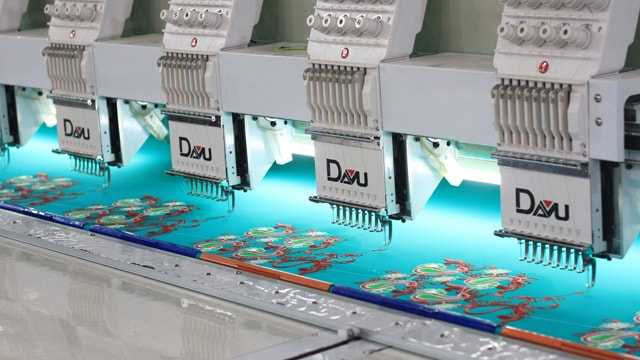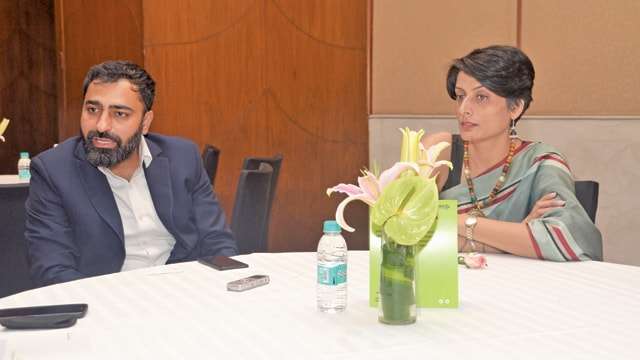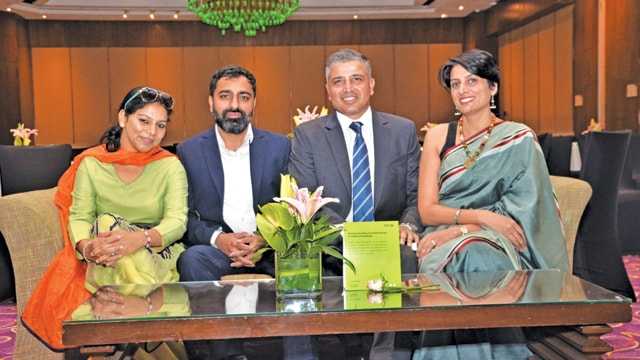
Computerised embroidery machines have today made it possible to replicate not only complex artworks into embroidered designs but also to produce lookalikes of hand embroidery. However, somewhere between transformation from hand to machine methods, embroidery industry also requires essential upgradation in the modules of training and better handling of the technical issues, which still remains a challenge. Vikas Kapoor and Kavita Ahlawat, Founders, EMBiQ, India are today challenging the traditional embroidery methods and are also providing the requisite training and education needed to uplift the embroidery industry in India. Talking to them on issues highlighting the myths was indeed educative.
Traditionally, embroidery has always been the forte of India. The country has been catering to the strong local and global demand for garments embellished with embroideries along with sequins and crystals. Despite being a sector having an extensive workforce of approximately 22 lakh, India is losing orders of embroidered garments to Bangladesh, Vietnam and Cambodia which, until a decade back, were considered laggards.
The reasons may be many, but primarily the country has not caught up with increasing the technical know-how and enhancing operators’ skills. When it comes to other functions in the textile chain such as sewing, a lot of trainers, consultants and educational institutes are actively involved but that’s not the case with embroidery.

Issue 1: Apparel manufacturers do not think of fabric utilisation before doing embroidery operations…
“Fabric is the biggest cost factor (about 60 per cent) in a garment. While doing embroidery, manufacturers always assume that fabric saving might have been done by the cutting department. This assumption is wrong. Fabric saving should come before embroidery profitability.”
Cost saving is not the duty of just one department. Wherever it can be saved, it should be saved. Until a few years ago, people in India only knew about the frame method of embroidery which, in fact, is bulky and consumes more fabrics; therefore, making the operation expensive. However, in 80 per cent cases, if embroidery is done without frame, then the manufacturers can save the fabric but unfortunately more than 70 per cent embroiderers in India including big export houses work on frame embroidery only and nobody is there to teach them about frameless embroidery. Another issue is that the single largest wastage in embroidery is fabric damage which occurs due to needle force. If embroidery rejection is 1 to 2 per cent and the manufacturers are able to control even 0.5 per cent, then they can manage to save a lot of cost. But still, the industry is not even giving a thought to these small yet strong solutions.
Issue 2: The industry is not aware about rising trim costs and its alternates…
“Embroidery trims’ cost was about 13-14 per cent a decade ago and now it has risen to 25 per cent. People do not even realise that this is one of the main reasons why embroidery in India is becoming costlier with every single year passing by.”
One of the examples of expensive trims is water soluble backing which is quite commonly used in embroidery. It is costlier than traditional backing. However, manufacturers in the Indian embroidery industry are not even trying to explore heat soluble backing which is easily available in the market and way much efficient than water soluble backing. Most parts in the world where embroidery happens, this backing is used because it does not use water to dissolve backing instead it uses heat. In 40 per cent of embroidery types, this heat soluble backing can be used.
Issue 3: Embroiderers do not realise that purchasing machine alone cannot do wonders…
“A very few of the manufacturers have a planned process in embroidery division. They think they have invested in technology and rest everything can be achieved easily.”
India is one of the favourite destinations for garment buyers due to its upper hand in high-end garments and value addition. Every system right from MIS, control systems to barcode system is here but the manufacturers refrain themselves from using these systems. It’s strange that despite investing heavily in embroidery machines, India still does not utilise these systems to the maximum in order to control subsequent costs such as labour cost, maintenance and operational costs. Nobody is targeting to reduce these costs in their embroidery units.
Issue 4: Stitch innovations and R&D are still laggards…
“Manufacturers are not adopting the embroidery stitch types that can help them make their garments aesthetically good with better productivity.”
Most of the garment units are using straight stitches in their garments while doing embroidery. However, the use of slant stiches will always make garments look good and require 13 per cent fewer stitches in embroidery than in case of straight stitches. This helps in better productivity because stitch length is more. But, due to lack of knowledge, the industry is not able to advise this method to the buyers. The result is increased use of straight stitches which raises the cost of operation and ultimately the manufacturers are losing orders due to high cost of embroidery.

Issue 5: Handling of needle breakage is crucial, yet this remains an untouched subject
“Most of the defects occurring during embroidery can be repaired but if the damage (such as fabric tearing) happens due to needle breakage, there is no way one can fix it up.”
The right method of checking the head centre is to bring down the needle path, then rotate the main head and bring it to 150 degrees. Then the technician has to check if the needle is at the centre of the needle hole. If the needle is not in the centre, he has to rotate or shift the head to match the centre. This is done by tightening the collar screw on both sides of the head. Now the most important thing to remember is to ‘bring the machine back to 100 degrees and lift the needle bar. However, this is where the technicians go wrong as they do not bring the machine back to 100 degrees.
Issue 6: Training is not an investment, still nobody is keen on doing it…
“Who is suggesting business owners that the thing which could not happen 6 months ago can happen now? Nobody. In sewing division, QA and QC have experience, abundant data, background, reference manuals, knowledge and everything else but the same QA and QC become helpless when it comes to embroidery.”
Millions of sewing operators are getting trained from Prime Ministers’ training institutes, but embroidery people are not seeing the light of the day. Sector Skill Council (SSC) added embroidery in its course two years back. But upon inquiry, it has been found that nobody is trained through SSC’s embroidery course. It is good to see that the Government felt the need to train people in embroidery but no training provider is coming forward. This shows how India is ignoring a sector where it could regain its stronghold just by providing trainings.
Trainings should be specifically designed for each department such as supervisor training, operator training, technician training and digitizer training.
In today’s era, the apparel industry is cribbing that cost is increasing, competition is getting stiffer and business is not running smoothly. But whenever there is talk about increasing efficiency, a very few of the manufacturers step out to adopt those solutions which improve efficiency. If productivity is not achieved in embroidery units, it is either because of the work environment or lack of skilled supervisors and operators. Both skills and environment can be improved by trainings. Until today, garment factories are training embroidery operators but they are not evaluating operators and finding out if they still lack on the required skills or not. This increases operational cost, therefore, India is losing business to other countries.
It’s a fact that a supervisor is the backbone of a manufacturing unit. However, due to lack of required skills in him, a factory cannot expect productivity on the shopfloor. Embroidery divisions are only providing him with an elementary machine handling training which is basically the job of the technology providers but today, he needs to understand which all designs are being manufactured on sewing machines and what it takes to manufacture those designs efficiently. Moreover, a supervisor should know how to control absenteeism by handling grievances.
Further, a skilfully punched design is the key to achieve best quality and high production output. However, without the appropriate use of stitch direction and density, based on the type of fabric and thread, even the best machines will not be able to give the desired visual effect or maximum production output. Unfortunately, most organizations are unaware about the power of a good design and hence there is a scarcity of good digitizers who are capable of achieving these standards in embroidery. Those who understand the importance, struggle to hire well-trained digitizers because market does not have trainers in this segment.
Similarly, the skilled embroidery machine technicians are only a few in number. They are either self-trained or get training from the machine suppliers which does not help in building a properly trained technician who can understand the importance of reducing downtime and all quality parameters required for offering quality embroidery.
Embroidery industry has to come out of its woes and look for proven solutions…
Despite the embroidery equipment being expensive, the industry is forced to hand it over to operators and technicians who do not have any formal training or skills. This results in low production efficiencies, poor product quality and high maintenance cost apart from the incomparable cost of loss of customer faith and opportunity. Embroidery Intelligent Quotient (EMBiQ) has a solution for these issues. The consultancy firm is dedicated to make things better and to make embroidery profitable for not only embroiderers but also the entire apparel and made-ups industry.
EMBiQ is launching a B2B portal and mobile app where every detail regarding embroidery is included in the form of images and videos. According to Vikas Kapoor, videos are powerful source of training. As he aptly states, “Everybody has mobile phones nowadays and whenever they come across any issue, they can watch the videos made by us in order to put an end to loopholes which exist in the embroidery segment.”
Moreover, EMBiQ has developed training content for every single module (operator, supervisor, technician, QA/QS and digitizer) separately in order to handle every challenge that the embroidery domain comes across. “Training people is our top-most priority and proudly speaking, we are the first education company in the country offering specialised consultancy and training for the embroidery industry,” concludes Kavita Ahlawat on a confident note.

Post a Comment